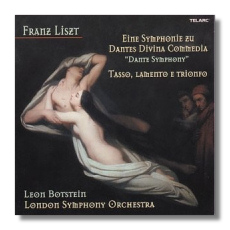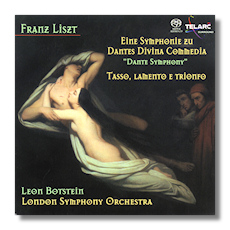
The Internet's Premier Classical Music Source
Related Links
- Liszt Reviews
- Latest Reviews
- More Reviews
-
By Composer
-
Collections
DVD & Blu-ray
Books
Concert Reviews
Articles/Interviews
Software
Audio
Search Amazon
Recommended Links
Site News
 CD Review
CD Review
Franz Liszt

Eine Symphonie zu Dantes Divina Commedia
- Dante Symphony
- Tasso, Lamento e Trionfo
London Symphony Orchestra/Leon Botstein
Telarc CD-80613 DDD 63:54
Also released on Hybrid Multichannel SACD SACD-60613
Amazon
- UK
- Germany
- Canada
- France
- Japan
- ArkivMusic
- CD Universe
)
Liszt never wrote any true symphonies in the usual sense of the word, but he wrote two multiple-movement works for orchestra and chorus that have symphonic pretensions. The Faust Symphony, completed in 1857, devotes one movement each to the troubled philosopher, Gretchen, and Méphistophélès, with a transcendental epilogue. It cost the composer much trouble – and about fifteen years – to write. The Dante Symphony, completed one year earlier, enjoyed a smoother birth. As in the Faust Symphony, Liszt enjoys the contrast between the infernal and the divine. Based, of course, on the Divine Comedy, the work is in two movements – an "Inferno" depicting the torments of Hell, and a tender "Purgatorio" in which the soul is prepared for Paradise. Apparently Liszt felt unequal to the task of depicting the soul's ultimate station musically. Instead, a gently radiant "Magnificat" brings the symphony to a close.
The symphony is a typical mixture of Lisztian rhetoric and inspiration. The secret to success is to churn through the rhetoric without apologies, and to savor the inspiration when it comes. Botstein is too tasteful to indulge himself in the hellfire of "Inferno." One can't quite smell the brimstone and hear the gnashing of teeth. Botstein's attempt to subdue the composer's vulgarity (at least in this movement) is admirable, but one might argue that vulgarity is precisely the point – this is Hell, after all. In the "Purgatorio," Botstein's soft-grained approach works much better, and the entrance of the chorus is truly magical. Unlike most (or all?) of the competition, Botstein uses a boys' choir in the "Magnificat." I believe that Liszt specified women's voices, yet it is hard to argue with the effect of disarming innocence that Botstein achieves here. In the closing moments of the Dante Symphony, Botstein's reading definitely comes into its own as competition against Barenboim, Masur, Kojian, and the like.
Tasso (subtitled "Lament and Triumph"), written in 1849, was the second of Liszt's thirteen symphonic poems. It is the story, told by both Goethe and Byron, of the poet Torquato Tasso, who fell afoul of Ferrarese society and yet was vindicated after his death. This symphonic poem, then, is one of those "darkness into daylight" works. Liszt tells the poet's story with music that is memorably melodious and dramatic; this is one of the highlights among the thirteen. Again, Botstein leads a reading that is free of vulgarity. Where other conductors offer a guilty frisson, Botstein is objective and quite convincing in his characteristically self-effacing manner.
The engineering, like the conducting, doesn't call attention to itself, but is nevertheless very fine. (Watford Town Hall in Watford, England was the venue.) The booklet notes are not very helpful.
Copyright © 2004, Raymond Tuttle





















